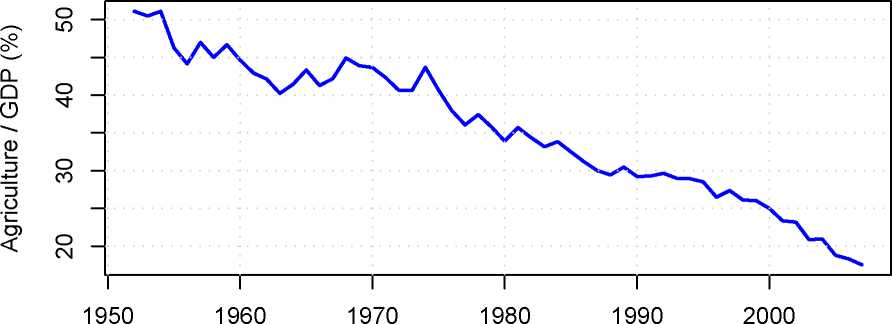Figure 1 Agriculture/GDP ratio

2.3.1 Monsoon shocks matter less
In the India of old, there was no conventional business cycle (Patnaik and Sharma, 2002).
A good year was one with a good monsoon and a downturn was generally about a bad
monsoon. These developments played out over a short horizon of one or two years. Output
fluctuations significantly reflected a succession of uncorrelated monsoon shocks - it was not
a conventional business cycle.
A major change in the behaviour of the Indian macroeconomy, then, consists of the
rapidly dropping importance of agriculture. As Figure 1 shows, the share of agriculture in
GDP has dropped quite sharply from 27% in 1996-97 to 17.5% in 2006-07.
In addition, the vulnerability of agriculture to the monsoon is declining through the
spread of irrigation. The linkages between agriculture and the economy are weaken-
ing. Putting these factors together, the domination of monsoon shocks in influencing
the macroeconomy has been substantially attenuated.
Linearly extrapolating into the future, agriculture may drop below 10% of GDP by
2013, by which time it would be an essentially insignificant part of Indian macroeconomics.
Agriculture will stop mattering for macroeconomics; within a few years, it will be just
another industry.
2.3.2 A more conventional business cycle
In recent years, large fluctuations of inventory and investment of firms have taken place, in
line with the mainstream notions of a conventional business cycle that is found in mature
market economies.
Several factors are at work here. In the old world, firms did not have operational flex-
ibility to invest. Firms were static, with fixed technology and minute product variation
More intriguing information
1. A Classical Probabilistic Computer Model of Consciousness2. THE EFFECT OF MARKETING COOPERATIVES ON COST-REDUCING PROCESS INNOVATION ACTIVITY
3. INTERPERSONAL RELATIONS AND GROUP PROCESSES
4. The name is absent
5. The name is absent
6. Pursuit of Competitive Advantages for Entrepreneurship: Development of Enterprise as a Learning Organization. International and Russian Experience
7. Benchmarking Regional Innovation: A Comparison of Bavaria, Northern Ireland and the Republic of Ireland
8. News Not Noise: Socially Aware Information Filtering
9. Natural Resources: Curse or Blessing?
10. POWER LAW SIGNATURE IN INDONESIAN LEGISLATIVE ELECTION 1999-2004